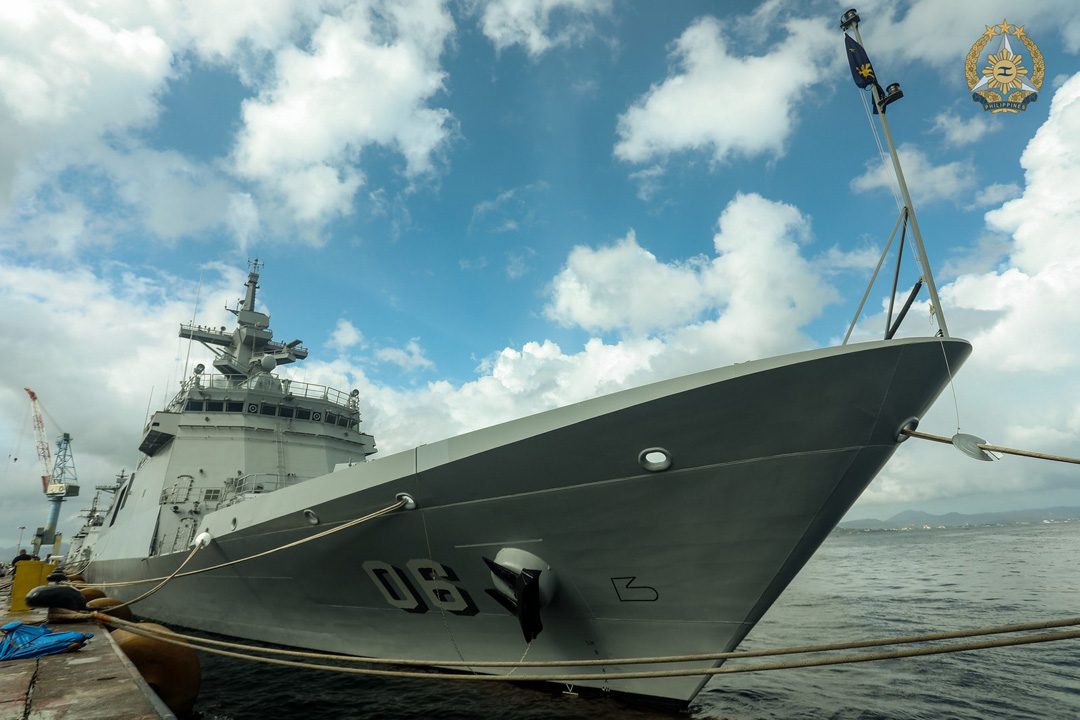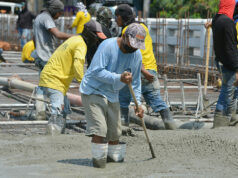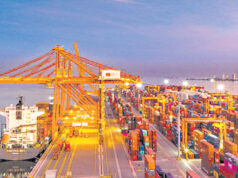Maiden mission: BRP Miguel Malvar’s vigilant watch begins

By Kenneth Christiane L. Basilio, Reporter
SUBIC BAY, ZAMBALES — The sound of a sharp whistle echoed through the BRP Miguel Malvar — the Philippines’ newest warship — at dawn on Wednesday, as a voice from the ship’s intercom called sailors to gather on the ship’s deck.
The vessel’s maiden mission is to hold exercises with US forces and patrol the South China Sea, which has become a major flashpoint amid worsening tensions between the Philippines and China.
Crew members were briefed about their tasks, and it wasn’t long before they started moving with practiced precision, untethering the thick ropes of the ship as it prepared to leave the Philippines’ Naval Operating Base in Subic Bay north of the capital.
On deck, about 30 men worked in tandem, their movements guided by a loud voice barking orders.
Then, two tugboats slowly flanked the warship, guiding it steadily from the port. At 6 a.m., the hum of the ship’s diesel engine whirred, a steady pulse signaling the warship’s departure into the open sea.
This was Philippines and US’ seventh joint exercise in the South China Sea since their “maritime cooperative activities” started in 2023 — drills meant to bolster their forces’ interoperability at sea amid China’s increased assertiveness in the waterway.
The US sent a detachment of marines stationed in Zambales province and a sea reconnaissance plane as part of the drill’s targeting exercises.
“This new ship is a symbol of our commitment to regional peace and stability in the Indo-Pacific region,” Philippine Navy Captain Paul Michael P. Hechanova, commander of BRP Miguel Malvar, told BusinessWorld in an interview. “This warship is a tool for us to assert our rights.”
BusinessWorld happened to be one of the few local and international media selected to cover the event on June 4.
The BRP Miguel Malvar is armed with missiles and torpedo systems and fitted with sonar, radar and electronic warfare capabilities. It was built by South Korean shipbuilder HD Hyundai Heavy Industries Co.
The namesake of its class ship, the Philippine frigate left South Korea in late March and was commissioned in late May.
BRP Miguel Malvar’s engines roared, smoke billowing from the stack as it powered through choppy waves for about two hours before meeting the Philippine Coast Guard (PCG) vessel BRP Cabra off the coast of Zambales.
The coast guard vessel belched black smoke against the blue skies as its twin engines pushed through the rough seas, seeking to catch up with the navy frigate while holding communication exercises as part of the drills.
CHINESE NAVY SHIP
Passengers aboard Miguel Malvar rocked back and forth as it showed no signs of slowing down. By 9 a.m., the coast guard ship had closed the gap, at about 100 feet.
Shortly after, we spotted a Chinese Navy ship near the horizon — its silhouette noticeable behind BRP Cabra. It was first detected about 10 nautical miles (18 kilometers) from the Philippine vessel and seemed to be monitoring the exercises, Mr. Hechanova said.
“We were the first to spot it,” Philippine Lieutenant Roilan S. Seño, combat information center officer of BRP Miguel Malvar, told BusinessWorld in in Filipino. “When we were about to rendezvous with BRP Cabra, we saw it and informed that someone was following her.”
“We monitored it during the conduct of the maritime cooperative activity,” he added.
The combat information center, which manages the ship’s weapon systems, were on high alert throughout the mission, especially after the Chinese vessel was detected, Philippine Ensign Krystlenn Ivany G. Quemado, the ship’s assistant anti-surface warfare officer, said in an interview.
“We maintain alertness at all times as part of our duty in the combat center, so that in case of any situation, we could react,” she said. “We have prepared for it, we have trained for it, so we were confident.”
The joint Philippine-US drills featured land- and air-based targeting after meeting with the PCG ship, with US Marines stationed in Zambales and an American sea reconnaissance plane coordinating strikes on decoy targets, according to a media brief given aboard the ship on Tuesday night, ahead of the drills.
The Philippines and China have repeatedly clashed over disputed South China Sea features, fueling tensions as both uphold their claims in the vital trade route.
A United Nations-backed tribunal voided China’s claims in 2016 for being illegal, a decision Beijing does not recognize.
China claims nearly all of the resource-rich waterbody based on a 1940s nine-dash line map, overlapping with the Philippines’ exclusive economic zone. These include Scarborough Shoal, a key fishing ground near major shipping lanes that lies about 249 kilometers from Masinloc, Zambales. Beijing seized it in 2012 after a standoff with Philippine forces.
By noon, we stepped into the ship’s cool interior, a stark contrast to the sweltering, humid deck.
Pushing through heavy pressurized doors, we were met with a gust of cold air, red floors that squeaked with every step and pipes lining the walls as we climbed two flights of stairs to reach the bridge — the heart of the ship’s operations.
There, we got a better view of the Chinese ship as a Philippine Coast Guard helicopter circled around BRP Miguel Malvar and BRP Cabra as part of the drills. The Chinese ship was still monitoring the exercises from the horizon hours after being spotted by the Philippine Navy.
The bridge ran like a well-oiled machine, with about 10 officers seamlessly managing the main control panels under the command of Mr. Hechanova, who was seated at the side, scanning the sea using binoculars.
BRP Miguel Malvar’s large, tinted windows softened the sunlight as two crewmates stationed at the side and front of the bridge scribbled notes on the glass about the ship’s sailing. Every so often, they called out vessels spotted on the horizon.
A navy officer guided us back on deck after the drills, but the tight stairwells made for a tricky descent.
The ship again moved forward at full steam, slicing through the waves as it headed back to Subic Bay just before sunset.
We docked before dusk as sailors hurried to secure the ship to the pier. A navy officer slipped while hauling a heavy rope across the wet deck, while senior officers taught crew members how to tie knots.
HIGH SPIRITS
Mr. Hechanova said the crew felt a sense of accomplishment after completing their sea exercise, crediting the extensive preparations that went with it.
“I have no doubt that I selected the best group for this,” he told reporters on the deck of the ship. “We’ve prepared a lot since last year. We’ve been training for months.”
BRP Miguel Malvar’s crew was rigorously selected, involving interviews and thorough reviews to ensure each member’s operational compatibility with the ship.
“The higher headquarters has set parameters for selecting officers and crew for new assets,” Mr. Seño said.
“We were interviewed so they could assess our reaction to certain situations,” Philippine Ensign Krystlenn Ivany G. Quemado, the ship’s assistant anti-surface warfare officer, told BusinessWorld.
The sailors chosen for BRP Miguel Malvar were finalized in August last year and flew to South Korea a month later for hands-on training with the ship’s manufacturer, Mr. Seño said.
“This maiden mission of BRP Miguel Malvar is a mix of excitement and challenge for the crew,” he said. “There’s the excitement of applying what we learned during our training in South Korea.”
He said they faced challenges during the mission, including some “lapses” since it had been months since the crew were aboard a vessel. “But in the coming weeks and months, our crew will be able to adapt to them.”
“We’re looking forward to more missions that will help and contribute to the maritime security we are striving to protect,” Mr. Hechanova said.



